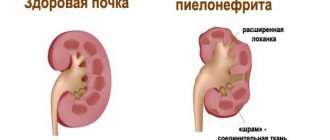Kidney malignancy ranks third among diseases of the urinary system. Both men and women are affected equally, and there are also cases of morbidity among young patients. The accelerated growth of pathology has become twice as high as it was during the Soviet era. This fact is explained by various reasons. The first place among them is occupied by such factors as the consumption of GMO products, fast food, carbonated drinks, environmental degradation, and increased stress.
Oncological pathology affects the kidneys with lightning speed. Cancer quickly metastasizes to other organs. The first symptoms are detected at stages 2-3, and sometimes even at the last. The absence of symptoms at the first stage of disease development misleads patients, so they seek medical help quite late. Symptoms of kidney cancer manifest themselves with a clear clinical picture in the later stages. A malignant tumor can be located in the left or right organ. If a patient has concomitant kidney diseases, he does not always pay attention to heaviness in the side and fatigue, as well as weight loss.
In the early stages or at the cellular level, urinary organ cancer is discovered by chance. This occurs during a physical examination or during random instrumental studies, such as ultrasound, MRI or computed tomography of the abdominal organs. Cancer in later stages resembles kidney failure or even urolithiasis, so treatment is carried out to eliminate these causes.
Only an instrumental study with the removal of histological material from the site of the lesion dispels doubts about oncology. Tissue sections provide reliable evidence of the origin of the tumor.
Kidney cancer: causes
There are a huge number of carcinogens that provoke the development of oncology, but no specific cause of kidney cancer has yet been identified. But there are still a number of factors that have an indirect effect on the formation and progression of a malignant neoplasm. Among them are:
- Age.
After 50 years, the risk of developing a tumor increases several times. This is due to the accumulation of spontaneous genetic mutations that can give impetus to the formation of a cancer cell, long-term temporary contact with external negative factors and a decrease in immunity with age.
- Floor.
Bad habits, untimely treatment of diseases, and occupational hazards lead to the fact that symptoms of kidney cancer are much more common in men than in women.
- Overweight.
Extra pounds are most often the result of hormonal imbalance in the body. As a result, female sex hormones (estrogens) accumulate in adipose tissue, which, if certain factors coincide, can provoke the development of oncology.
- Smoking.
Among non-smokers, patients with kidney cancer are half as common as among those exposed to this bad habit. Substances contained in cigarettes and cigars have a powerful carcinogenic effect.
- Severe forms of kidney pathology.
Such diseases require long-term medication and maintenance of vital processes using dialysis (artificial kidney). The normal functioning of the kidneys becomes impossible, which contributes to the development of oncology.
- Prolonged contact with chemicals.
Various dyes, organic solvents, household chemicals and the like have a negative effect on the kidneys and other organs of the urinary system.
- Exposure to radiation and ionizing radiation.
Man-made disasters, polluted environmental conditions, and agricultural activities using radiation materials lead to malignant degeneration of kidney tissue.
- Genetic kidney pathologies.
Congenital anomalies of the anatomical structure of the organ, Hippel-Lindau disease, papillary cell carcinoma and others are risk factors in the development of a malignant process.
- Self-medication.
Long-term and uncontrolled use of analgesics, metabolic drugs, antibacterial or diuretics causes changes in the kidney tissue, leading over time to the formation of a tumor.
- Hereditary predisposition to malignant tumors.
If there is a history of kidney cancer in the family, the likelihood of this pathology occurring in close relatives increases significantly. Especially if brothers/sisters have the disease.
- Polycystic kidney disease.
The disease can be congenital or acquired. A characteristic feature is the formation of multiple bubbles filled with liquid. Cysts disrupt the functioning of the kidneys, thereby promoting the development of cancer.
- Hypertonic disease.
It is considered one of the aggravating factors in the formation of cancer tumors in the kidneys. It is still not completely clear what exactly is the trigger for cell degeneration - high blood pressure itself or regular use of antihypertensive drugs for a long time.
The presence of these factors does not indicate that kidney cancer will definitely appear. It also cannot be said that in the absence of these causes there will be no cancer. In each case of the disease, the history of its development is individual.
What causes oncology: reasons
Symptoms of kidney cancer are diagnosed 2 times more often in representatives of the stronger sex than in women.
Until now, experts have not been able to determine the true primary source influencing the manifestation of a malignant neoplasm. It is believed that the development of oncology is influenced by gene mutation, against the background of which pathological growth of cancer cells occurs. A similar phenomenon is observed under certain factors in which renal pelvis cancer is diagnosed many times more often:
- Active smoking and excessive drinking. Such habits negatively affect the condition of the organ and the whole organism.
- Problems with excess body weight. An obese person is at risk of developing kidney cancer. Even at an early stage of obesity, there is a high risk of cancer.
- Mechanical damage to the organ. A fall or puncture wound causes damage to the kidney tissue, which can lead to kidney cancer.
- Long-term drug therapy.
- Hereditary factor. If cancer was in blood relatives, then the risk is often inherited, and the disease can even manifest itself in a child.
- Regular exposure of the body to radiation and aggressive chemical components.
- Chronic diseases of the kidneys and other internal organs.
Kidney cancer classification
Malignant parenchymal tumor of the kidney - what is it? In an organ, for a number of reasons, healthy cells degenerate into malignant ones and begin to divide uncontrollably, forming a tumor. Of all cases of kidney cancer, 90% are renal cell carcinoma. A cancerous tumor is formed from the epithelial tissue of the collecting ducts and renal tubules. If the epithelium of the pyelocaliceal system is involved in the malignant process, then it will be transitional cell carcinoma.
Renal cell carcinoma of the kidney is divided into the following subtypes:
- Clear cell carcinoma of the kidney. This type is also called hypernephroid cancer or Gravitz tumor. Consists of parenchymal epithelial tissue. A characteristic feature is the presence of a fibrous capsule, which encloses cancer cells in the initial stages of the disease.
- Chromophilic or papillary kidney cancer. With this type, the process is most often two-way.
- Chromophobe kidney carcinoma. It is rare and practically does not metastasize. After tumor removal, the prognosis is most often favorable.
- Oncocytic cancer. Characteristics are similar to the chromophobe form of cancer, but is formed from eosinophilic, rapidly growing large particles. The tumor can grow to large sizes.
- Collecting duct cancer. Of all cases of kidney cancer, this type occurs in only 1% of patients. It is distinguished by the migration of metastases throughout the body and the inflammatory process around the tumor.
- Williams tumor. Develops in childhood.
Among all types of kidney cancer, sarcoma is distinguished, which is characterized by damage to both kidneys, malignancy of the process, rapid metastasis and high mortality. Depending on the type of tissue affected, there are:
- angiosarcoma - vascular walls are affected;
- adenocarcinoma of the kidney - formed from glandular tissue;
- myosarcoma – muscle tissue is involved;
- fibrosarcoma - the basis of the tumor is connective tissue.
A classification of kidney cancer has been developed to determine the degree of malignancy of tumor cells. The indicator is denoted by the English word grade (abbreviated by the letter G), along with it a digital index for tumor differentiation is indicated:
- clear cell kidney cancer grade 1, the tissue is practically healthy and there are almost no changes;
- renal cell carcinoma of the kidney g2, a moderate degree of differentiation is noted;
- clear cell renal cell carcinoma of the kidney g3, poorly differentiated cells are available;
- kidney blastoma g4, cell differentiation does not occur, tumor tissue is significantly different from normal;
- clear cell kidney cancer Gx, the degree of differentiation is not determined.
The higher the number, the more malignant the process, indicating the aggressiveness of the tumor and an unfavorable prognosis.
For kidney cancer, the TNM classification is carried out, where:
- T – tumor size:
- Tx – there is no way to evaluate the tumor.
- 0 – no information about education.
- T1 – the tumor reaches up to 7 cm in diameter, but does not extend beyond the boundaries of the organ. 1a indicates formation up to 4 cm, 1b over 4 cm, but not more than 7.
- T2 – tumor is more than 7 cm, but does not cross the border.
- T3 - indicates damage to large veins and adrenal glands, but the tumor does not spread beyond the renal fascia. T3a – perinephric tissue or adrenal gland is affected. T3b – large vena cava below the diaphragm is affected. T3c – the tumor has grown into the wall of the inferior vena cava or has spread to this vein above the diaphragm.
- T4 – the neoplasm extends beyond the boundaries of the fascia.
- N – regional lymph nodes:
- Nx – it is not possible to identify lymph nodes.
- N0 – regional lymph nodes are not affected.
- N1 – metastases in a single lymph node.
- N2 – metastasis to a large number of lymph nodes is noted.
- M – distant metastases:
- Mx – distant metastases are not detected.
- M0 – metastasis is not diagnosed.
- M1 – distant metastases have appeared.
ICD 10 code for kidney cancer is C64, for oncology of the renal pelvis - C 65. ICD 10 code for cancer of the left kidney is C 64.1, right - C64.0.
Stages
The stage of cancer describes the size of the tumor and its spread.
When staging is based on clinical assessment alone, it is called clinical staging. The standardized way in which oncologists describe the morphological grade of cancer is the TNM staging system. According to this system, three main parameters are taken into account in determining the stage:
- T - tumor size from 1 to 4;
- N—presence of affected regional lymph nodes: 0 or 1;
- M—presence of distant metastases: 0 or 1.
Based on these parameters, the clinical stage of the cancer is determined.
Stage 1 - The cancer is only in the kidney, has not spread and is less than 7 cm in size. Five years after surgery for such a tumor, nine out of ten people will be alive and free of cancer.
Stage 2 - The cancer is larger than seven centimeters, but is still limited to the kidney and has not spread beyond it. After surgery, the five-year survival rate is still very high for this stage of kidney cancer.
Stage 3 —The cancer has spread beyond the kidney but has not spread to distant organs. For example, the cancer may have spread to the fat around the kidney, to a blood vessel leaving the kidney, or to the lymph nodes near the kidney. The likelihood of a surgical cure is lower, but not zero.
Stage 4 —Kidney cancer has spread widely beyond the kidney, into the abdomen, adrenal glands, distant lymph nodes, or to other organs such as the lungs, liver, bones, or brain. This stage of cancer is unlikely to be curable, but it is possible to control the disease by inhibiting tumor development.
Kidney cancer: symptoms and signs
The kidneys are a paired organ; they are located in the retroperitoneal space. Their main purpose is:
- urine formation;
- removal of toxic substances and metabolic products;
- maintaining blood pressure at an acceptable level;
- production of hormones;
- participation in hematopoietic processes.
The tumor most often develops on one side, but sometimes bilateral lesions occur. Symptoms and signs of the disease in kidney oncology depend on many factors, including the stage of the process, the age of the patient, the general condition of the body, concomitant diseases, and the presence/absence of metastases.
In the first stages, there are usually no complaints; the disease is diagnosed accidentally. As the cancer process progresses, the patient's condition worsens. Increasing dysfunction, which invariably occurs with a kidney tumor, contributes to the appearance of characteristic symptoms.
Men and women share common specific and nonspecific symptoms and signs of kidney cancer. The first group includes the following complaints:
- Discomfort in the lumbar region.
Symptoms of kidney cancer include constant aching pain that occurs as a result of tumor compression of tissues, blood vessels and nerve endings. The patient notes pain in the abdomen and the projection area of the kidney on the side where the tumor forms. Over time, the pain becomes constant and more intense. When blood clots appear in the bladder, blockage of the ureter, tumor rupture or hemorrhage into the tumor, the functions of the urinary system are disrupted. All this causes acute severe pain, similar to that occurring with renal colic.
- The appearance of blood in the urine.
Blood in the urine may be a sign of kidney cancer. Very often it is discovered completely by accident, and there are no reasons that could cause hematuria. Bloody discharge disappears on its own, only to reappear after some time. As the condition worsens, hematuria can become one of the causes of blood loss, causing anemia.
- Determination of the formation of a dense consistency upon palpation of the lower back and abdomen.
When the disease moves to a more severe stage, in some cases it is possible to palpate the presence of a formation, especially if the patient is thin. The growth of the tumor to a significant size allows it to be felt even through the abdominal wall. This symptom is not always informative; its absence does not exclude kidney cancer.
In the early period, 1-2 symptoms are noted; as kidney cancer develops, the symptoms begin to appear in a complex.
You can suspect the presence of oncology based on nonspecific signs, including:
- persistent increase in blood pressure;
- constant fatigue;
- increased weakness;
- excessive sweating (hyperhidrosis);
- untreatable swelling in the legs;
- decreased or lack of appetite;
- sudden weight loss.
A characteristic feature
How does kidney cancer manifest itself at stages 3–4? When metastases appear in various organs and systems, complaints appear related to disruption of their functions:
- when the lungs are affected, hemoptysis, persistent cough and shortness of breath are observed;
- metastases in the liver are indicated by jaundice of unknown origin and signs of liver failure;
- pathological fractures and severe pain in the bones indicate metastasis of the tumor to the bone tissue;
- the brain and/or spinal cord affected by metastases reacts with severe headaches, dizziness, neuralgia and other neurological symptoms.
In women, dermatological problems are added to other symptoms of kidney tumors: the number of tumors on the skin increases, an unhealthy complexion appears, and pimples form. With kidney cancer in men, signs of the disease appear such as varicocele, when the veins of the spermatic cord begin to dilate due to venous stagnation. In smokers, shortness of breath is more pronounced and is most often accompanied by hemoptysis. Recurrence of kidney cancer is characterized by return of symptoms and increased pain.
Metastatic manifestations
Local tumor growth leads to metastasis to the adrenal glands and pancreas. With the flow of lymph, kidney cancer spreads to nearby (regional) lymph nodes, with blood - to the lungs, bones, liver, and brain. The appearance of distant metastases is always a sign of stage 4 development. In this case, symptoms of metastatic organ damage may occur earlier than signs of the primary tumor.
- Metastases to the lungs are manifested by cough, blood in the sputum, shortness of breath, and chest pain. The radiograph reveals round formations, single or multiple.
- Symptoms of liver metastases are pain and heaviness in the right hypochondrium and signs of liver pathology, similar to the manifestations of nephrogenic hepatopathy described above. However, quite often damage to this organ is asymptomatic.
- Bone metastases most often form in the spine, pelvic bones, femur and shoulder. Manifested by pain. Destruction of bone tissue by a tumor leads to pathological fractures under minor loads.
- Brain metastases cause increased intracranial pressure. They manifest themselves as migraine-like pain, which intensifies at night and in the morning, dizziness, vomiting, which is not associated with food intake and does not bring relief.
Stages of kidney cancer and routes of metastasis
Depending on the size of the tumor, its growth into neighboring organs and metastasis, 4 stages of kidney cancer are distinguished:
- At the first stage, the formation is no more than 7 cm in diameter, is located within the organ and does not metastasize. There are no symptoms of the disease, only sometimes there is a low-grade fever and a dull aching pain on the side of the kidney affected by the pathological process. When diagnosed at this stage, the prognosis is most positive.
- In the second stage, the tumor reaches 10 cm and grows into the renal capsule, but does not extend beyond the boundaries of the organ’s fascia. At this stage of kidney cancer, metastases have not yet formed, malignant cells begin to differ from healthy ones, but the tumor itself grows quite slowly. There are no signs of cancer yet, but overall my health is getting worse. The patient is concerned about weakness, constant fatigue, lability of blood pressure, loss of appetite and weight.
- At the third stage, germination into nearby organs and penetration of malignant cells into the lymphatic system is noted. At this stage, the tumor on the kidney may involve the aorta and inferior vena cava. The main complaint is a persistent increase in blood pressure. In addition, the patient is concerned about liver problems, sudden weight loss, lack of appetite, disturbances in the gastrointestinal tract, urinary and respiratory systems.
- Stage 4 kidney cancer is characterized by a large tumor size, its invasion into the organs of the retroperitoneal space, and an aggressive course. With advanced kidney cancer, metastasis occurs throughout the body. The pain syndrome increases, the functioning of all organs and systems is disrupted.
Where else does kidney cancer metastasize? In 60% of oncology cases, metastases travel through the blood and lymph into the lungs. In addition, they are found in the brain, adrenal glands, bone tissue, liver, intestines, and bladder. In men, metastases can be in the prostate, in women - in the mammary gland. In some cases, pathological lesions may appear many years after the onset of the disease.
Remember, despite the presence of stage 4 kidney cancer, you need to move on with your life, the experienced specialists of our clinic in Moscow will help you with this. Oncologists of the highest qualification and having various scientific degrees are always ready to conduct diagnostics, develop a treatment protocol and immediately begin treatment.
Stages of cancer
- 1 Degree. The tumor does not exceed 7 cm, can be from 2 to 5 cm. If detected early, the survival rate is 90%.
- 2nd Degree. The tumor reaches 10 cm, the tumor does not grow into surrounding tissues. There is a clear boundary between affected and healthy cells. Timely detection and slow growth of the tumor give a favorable prognosis, survival rate is 70%.
- 3 Degree. The size of the neoplasm is significant, but does not exceed the size of the organ. There is germination into large vessels, perinephric tissue, and adrenal gland. The prognosis is made on a case-by-case basis; the five-year survival rate drops sharply within the range of 39-65%.
- 4 Degree. The tumor is large and grows beyond the organ. There are multiple metastases found in the lungs, liver, and bones. There are no optimistic forecasts, since relapses are possible after a 3-4 year period. Survival rates range from 14 to 29%.
How to identify kidney cancer
The presence of high-precision equipment in our clinic in Moscow allows us to detect kidney cancer at the very beginning of the disease. Unfortunately, most often this happens during examination for a completely different reason, because in the initial stages the incipient tumor does not manifest itself in any way. If a malignant neoplasm is suspected, after collecting an anamnesis, visual examination and palpation, the patient is prescribed the following types of examination:
- Instrumental. These include:
- Ultrasound examination. Internal organs, kidneys and retroperitoneal space are examined. Ultrasound determines the structure of the tumor in the kidney, location and size. Differential diagnostics are carried out to determine the type of process. An ultrasound can clearly determine whether a kidney tumor is developing, whether there is a benign mass formation or cysts. The only drawback is that if the patient is overweight, signs of kidney cancer on ultrasound are difficult to determine. The description of the study allows the attending physician to decide on treatment tactics in the future. The method is economical, informative and safe for the patient’s health, therefore it is widely used for diagnosis and screening.
- Computed tomography (CT). The accuracy of layer-by-layer X-ray examination reaches 95%. Of particular value is additional intravenous contrast. The use of this method makes it possible to determine the characteristics of a tumor in kidney cancer using the tnm system (size of formation, degree of damage to lymph nodes and the presence of metastases).
- Magnetic resonance therapy (MRI). In image sections of the affected organ obtained using an electromagnetic field, the location of the tumor, its structure, and the presence of metastases are clearly visible.
- Cystoscopy. Used as an additional remedy if a tumor formation in the bladder is suspected. A cystoscope is inserted through the urethra and the inner surface is examined to detect a tumor.
- Needle biopsy.
A puncture needle is inserted into the tumor tissue under the control of an ultrasound machine, then a piece of the affected tissue is removed with its help and a laboratory test is performed. Using IHC (immunohistochemistry), the classification of kidney cancer is determined.
- X-ray.
- Urography of the kidneys. There are survey, retrograde and intravenous research methods. In the first case, contrast is not used, in the second, the contrast agent is injected into the bladder through a catheter, in the third, intravenously. A series of x-rays are then taken. Symptoms of a kidney tumor on urograms include changes in the contours, size and location of the organs of the urinary system, as well as their functional state.
- Renal angiography. The contrast agent is injected through a special catheter into the aorta, located above the branch of the renal arteries. If kidney cancer is present, the tumor becomes clearly visible on photographs.
- Osteoscintigraphy (radioisotope scanning). Bone tissue is scanned using radioisotopes that tend to accumulate in places with a high level of metabolism, such as oncological formations.
- X-ray of the lungs.
Images are taken to detect distant metastases in the chest.
- Laboratory.
- General urine analysis. The absence/presence of blood, protein, and leukocytes in the urine is determined, which may indirectly indicate the presence of a pathological process in the kidneys and ureters.
- General blood analysis. It is prescribed to determine hemoglobin, leukocyte levels, the number of immature red blood cells and other signs of a malignant process.
- Blood chemistry. An increase in indicators such as creatinine, alkaline phosphatase, urea and uric acid is possible with the development of malignant tumors in the kidneys.
- Blood for tumor markers.
A tumor marker is a specific protein produced by tumor cells or the body itself. In kidney cancer, different types of tumor markers are determined, but first of all, attention is paid to the NSE marker. Exceeding its indicators signals the presence of a pathological process, but to make a more accurate diagnosis, a number of additional studies should be carried out.
Our clinic is equipped with modern equipment, the examinations of which are carried out by highly qualified specialists, which eliminates errors in diagnosis. Detection of the disease at the initial stages allows you to preserve the kidneys and the same quality of life without the use of drastic measures.
Diagnostics
To determine kidney cancer, you need to visit a general practitioner, who will prescribe initial tests and then refer you to a urologist. Or, if there is such a specialist in the nearest clinic, go straight to a urologist or nephrologist.
The basis for examining the patient will be complaints, examination data and the collected life history. If there have been cases of cancer in your family (parents, close relatives), you must inform a specialist about it. All complaints, symptoms and signs of concern, as well as the time of their appearance, must be clearly described. This will significantly reduce the time and speed up the diagnosis, and therefore the speed of prescribing therapy.
The examination includes laboratory methods (tests) and instrumental studies (ultrasound, etc.).
- Blood: general analysis with formula (detailed); biochemistry; determination of hemoglobin level, erythrocyte sedimentation rate (ESR); tumor markers.
- Urine: general analysis, according to Nechiporenko.
- Ultrasound examination of the kidneys.
- Computed and magnetic resonance imaging.
- General radiography, x-ray of the kidneys with contrast agent.
- Laparoscopy and biopsy.
- Radioisotope studies of the kidneys, angiography.
The results obtained from all of the above studies will become the basis for making a diagnosis or prescribing additional (repeated) examinations.
You shouldn't be afraid of being diagnosed with kidney cancer. Timely diagnosis, especially in the early stages of the development of the process, will avoid a pessimistic prognosis and contribute to almost 100% cure.
Treatment
Treatment tactics for a kidney tumor are selected depending on the stage of the process, location and general condition of the patient. How long you live with a kidney tumor after symptoms appear depends on when treatment is started. Timely therapy at the first stage helps to achieve stable remission and significantly reduce the risk of metastases that worsen the life prognosis. According to clinical recommendations, surgical treatment and alternative methods are prescribed for kidney tumors.
The most optimal treatment option is surgery, which achieves long-term remission. There are several types of operations to remove a kidney with a tumor:
- Kidney resection. For cancer, it is used if the tumor is small in size (no more than 4 cm), the only kidney is affected, dysfunction is observed in the second kidney, or the patient is at a relatively young age. A third or half of the kidney is removed along with the tumor.
- Nephrectomy. If the disease has reached stage 2 or growth of the tumor into the renal pelvis is observed, but the second kidney is working normally, then an operation is performed to completely remove the kidney with the tumor.
- Combined method. Indicated if the tumor reaches a large size or grows into surrounding tissues. surgery to remove a kidney with a tumor; in addition to the kidney, parts of nearby organs and large vessels are removed.
The consequences after removal of a kidney with a tumor can be different, ranging from damage to surrounding organs and ending with profuse bleeding. After resection, recurrence of kidney cancer is possible; this is facilitated by undetected and accidentally left malignant cells.
After removal of a kidney with a tumor, a special diet is prescribed. Patients are recommended:
- limit the consumption of salt and spices;
- take freshly prepared food in fractional and small portions;
- exclude canned, fried, smoked foods;
- drink fluids of at least 1.5 liters per day.
Food should be easily digestible and fortified. The diet must include fish, lean meats, whole grain bread, dairy products, fresh vegetables and fruits. Dishes are best steamed or stewed.
According to reviews, the postoperative period after removal of a kidney with a tumor, carried out in our clinic, proceeds without any special complications. Here, patients are provided with round-the-clock care and supervision by the attending physician, so at the slightest suspicion of a deterioration in their condition, all necessary measures are taken to ensure a successful recovery.
During the rehabilitation period after removal of a kidney with a cancerous tumor, adequate physical activity, avoidance of heavy lifting, and compliance with the recommendations of the attending physician are necessary.
After surgery, chemotherapy is prescribed to prevent relapse and spread of metastases. If drugs are prescribed after surgery, then we are talking about adjuvant chemotherapy. In cases where surgery is not possible due to the presence of a tumor in the last stage, neoadjuvant treatment is performed. Recently, insensitivity of cancer cells to chemotherapeutic agents has become common, and drugs in this group have a very negative effect on human organs and systems, so more modern treatment methods are increasingly being used for kidney oncology.
Innovative developments in the field of medicine make it possible to treat kidney tumors without surgery. The following methods are used:
- Renal artery embolization.
When using this method, the afferent artery is blocked, as a result of which the substances necessary for growth cease to flow to the tumor. As a result, the formation may be significantly reduced in height.
- Radiation therapy.
Prescribed as palliative treatment to relieve pain and improve general well-being. It also helps slow down the spread of cancer in the body. The tumor itself is practically insensitive to radiation exposure.
- Immunotherapy.
For kidney cancer, it is prescribed in combination with radiation and is used to activate protective forces. Immunotherapy can be specific when the vaccine is based on heat shock protein and tumor tissue. If the vaccine consists of peptides and embryonic cells, then we are talking about nonspecific immunotherapy. After removal of a kidney without metastasis, using this method in cancer patients reduces the relapse rate by 10%. The vaccine has no effect on metastases.
- Cryo- or radioablation of the tumor.
A high-frequency current or nitrous oxide is applied through a probe to the tumor-like formation in the kidney. In this case, a limited tumor is completely eliminated; in the case of an accumulation of several nodes, the main one is “burned out.”
- Innovative treatment methods:
- Targeted therapy. For kidney cancer, drugs are prescribed whose action is aimed at destroying specific proteins produced by the malignant tumor. As a result, the growth of the formation slows down, the uncontrolled proliferation of pathological cells stops and metastases do not form. The negative aspects of using this method are the rapid adaptation of tumor cells to the drugs and a large number of side effects. Most often, targeted therapy is used in combination with other treatments.
- Gene therapy. The division of pathogenic cells is affected at the gene level. The introduction of pre-modified cells helps stop tumor growth and achieve its regression.
- Neutron therapy. Irradiation is carried out with microparticles in which there is no electrical charge. As a result, they penetrate deep into the malignant cell and attract toxic substances, due to which the tumor grows. In this case, there is no damage to healthy tissue. Neutron therapy has a positive effect on the body even in the presence of 3-4 stages of cancer, especially if the tumor is pre-impregnated with boron, gadolinium or cadmium before the procedure.
- Chemoembolization. Standard chemotherapy for kidney cancer is ineffective, while local chemotherapy leads to positive results. During the procedure, the blood flow going to the tumor and feeding it is blocked. Then a drug with an antitumor effect is injected into the artery.
Treatment for a tumor of 2 kidneys consists of preserving the function of at least one organ of the pair as much as possible. If this is not possible, then the issue of transplanting a donor kidney has to be addressed.
As an alternative therapy, treatment for kidney tumors can be supplemented with folk remedies. It should be remembered that the use of medicinal herbs must be agreed upon with the attending physician. Self-medication can lead to a worsening of the situation: tumor growth and the appearance of metastases.
Chamomile, yarrow, plantain, and mint are used to remove toxic substances produced by the tumor. As a pain reliever, you can use tincture of hemlock or aconite. Wheatgrass, rowan, heather, chicory, rosehip, lungwort, dandelion, nettle - the list of plants that can suppress tumor growth, improve the patient’s well-being, relieve pain, increase immune status, and normalize metabolism is quite extensive.
Diagnosis of the disease
To identify oncology, the patient must undergo the following measures:
1. Blood and urine tests. A general blood test shows an increase in ESR, leukocytosis and a decrease in hemoglobin levels, which indicates an inflammatory process in the body. A biochemical blood test reveals hematuria, which is a sign of a tumor. In addition, tumor markers are used to identify a malignant tumor.
2. Ultrasound examination. This is a simple and inexpensive research method that allows you to determine the structure of the tumor, tumor size, location, and impact on other organs. Ultrasound also detects regional and distant metastases.
3. Radiography. In some cases, doctors resort to contrast urography, i.e. to the injection of a contrast agent into the vein. When the substance enters the kidney, it is shown on x-rays, allowing the condition of the ureter and the excretory function of the kidneys to be assessed.
4. CT and MRI. These are modern and most informative diagnostic methods that allow you to examine the area affected by a cancer tumor, and therefore determine the stage of cancer development and detect metastases in individual organs.
5. Needle biopsy. To verify the presence of a cancerous tumor, specialists take a puncture from the patient. To do this, a long, thick needle is inserted percutaneously into the kidney cavity, where a piece of tissue is collected, which is then sent for histological and cytological examination. This makes it possible to verify that the organ has actually been affected by a malignant tumor and to establish the type and extent of the lesion.
6. Endoscopic method. In some cases, to collect tissue and subsequent examination, an endoscope is inserted into the opening of the peritoneum in the area of the kidneys, with which the external condition of the kidney is examined and a piece of tissue is taken for biopsy.
Life prognosis for kidney cancer
When asked how long people live with kidney cancer, experts give an ambiguous answer. It all depends on:
- at what stage the tumor was detected;
- the malignant process is occurring within the renal capsule or has already gone beyond it;
- whether pathological cells have penetrated the lymphatic system or not;
- whether there are metastases to other organs.
If 5 or more years have passed after the treatment, and remission continues, then with a greater degree of probability it can be said that a relapse will not occur.
The prognosis after removal of g3 clear cell renal cell carcinoma, if detected at an early stage, is very optimistic. If cancer is detected at the first stage after proper treatment, stable remission is observed in 90% of patients, and the five-year survival rate is within 80%. For stage 2 clear cell renal cell carcinoma, the prognosis is less favorable. The five-year survival rate is 74%.
After removal of stage 3 kidney cancer, according to the forecast, the five-year survival rate is 50% of all cases of the disease. If surgery was performed against the background of metastasis, then according to forecasts, after removal of kidney cancer, only 5% of patients survive for five years.
If kidney cancer is detected at stage 4, the prognosis, in the absence of adequate treatment, is extremely unfavorable. In this case, to the question of how long they live after the onset of symptoms of kidney cancer, the answer is the same for women and men: if the tumor is not removed, then death occurs after one, maximum two years.
How and how long people live with one kidney after cancer largely depends on the patients themselves. Following the recommendations of the oncologist, maintaining a healthy lifestyle and a positive attitude can significantly increase this indicator.
Treatment tactics and prognosis
Treatment is exclusively surgical. The prognosis of renal cancer depends on the stage, general condition, immune system and concomitant pathologies. The earlier cancer is detected, the better the treatment with a positive prognosis.
Surgical treatment of the second and third stages has a 70% chance of success and 10-15 years of full life in remission without relapse.
At the fourth stage, surgical treatment guarantees 4-5 years of life, only with a good immune system and the body’s resistance to infections; in other cases, kidney cancer cannot be effectively treated, the prognosis is dismal with a fatal outcome.
Treatment of kidney cancer in Moscow
Tumor diseases of the kidneys require increased attention from specialists. Our oncology clinic in Moscow is ready to accept patients with this disease for treatment. We have all the resources for this:
- the most accurate diagnostic equipment;
- modern consumables;
- experienced oncologists with the highest qualification category and scientific degrees;
- personnel specially trained to care for postoperative patients;
- dietary nutrition;
- comfortable rooms.
The scientific developments of our specialists contribute to the detection of kidney oncology at the initial stages and the successful fight against the disease. You can find out how much an operation to remove a kidney tumor costs by calling the phone number provided.
Author
Alexey Andreevich Moiseev
Head of the Oncology Department, oncologist, chemotherapist, Ph.D.
Forecast
The life expectancy of patients with RCC depends on many factors:
- tumor size and extent;
- the presence of lymphogenous and hematogenous metastases;
- presence of venous thrombosis;
- patient's age;
- general condition;
- histological type of tumor.
Kidney cancer detected at the first stage is curable in 90% of cases. Five-year survival rate of patients with stage 2. after organ removal is about 60%. Patients with generalized RCC live no more than 6 months without treatment. Targeted therapy can slow progression and prolong life by months and even years.
Bibliography
- ICD-10 (International Classification of Diseases)
- Yusupov Hospital
- Cherenkov V. G. Clinical oncology. — 3rd ed. - M.: Medical book, 2010. - 434 p. — ISBN 978-5-91894-002-0.
- Shirokorad V.I., Makhson A.N., Yadykov O.A. The state of oncourological care in Moscow // Oncourology. - 2013. - No. 4. - P. 10-13.
- Volosyanko M.I. Traditional and natural methods of preventing and treating cancer, Aquarium, 1994
- John Niederhuber, James Armitage, James Doroshow, Michael Kastan, Joel Tepper Abeloff's Clinical Oncology - 5th Edition, eMEDICAL BOOKS, 2013
Clinical stages
Oncologists distinguish four stages based on the TNM classification data
| Stage | Index T | Index N | Index M |
| I | T1 | N0 | M0 |
| II | T2 | N0 | M0 |
| III | T3 | N0 | M0 |
| T1-3 | N1 | M0 | |
| IV | T4 | N any | M0 |
| T any | N2 | M0 | |
| T any | N any | M1 |
Varieties
The neoplasm most often occurs in the surface layer of the kidneys, growing deeper into them over time. The tumor consists of a mass of kidney cells. These particles begin abnormal division without taking part in the production of urine and blood purification. There are several types of renal carcinoma:
1. Collecting duct carcinoma. The tumor grows rapidly. The rarest form of kidney cancer.
2. Clear cell carcinoma. Formed from particles containing light cytoplasm. Diagnosed in 86% of cases.
3. Papillary. It is localized simultaneously in both kidneys, in the vast majority of cases it is multiple in nature. It occurs rarely, only in 14% of cases.
4. Chromophobe kidney carcinoma, renal cell. A characteristic feature of this carcinoma is its slow growth. Occurs in 4% of cases.
5. Oncocytic. Formed from large, eosinophilic particles. Metastases occur rarely. Diagnosed in 5% of patients.
Symptoms
For the most part, carcinoma is discovered incidentally when a patient is being examined for another reason. As a rule, pathology in the initial stages (before metastasis) occurs in a latent form. Basic, general and nonspecific symptoms are distinguished.
The main signs of renal carcinoma include:
1. Hematuria, or the appearance of blood in the urine. The amount of blood may be significant or insignificant. In the latter case, the disease is detected by a urine test. Hematuria is not accompanied by unpleasant sensations and appears with varying frequency. Bleeding develops against the background of destruction of kidney tissue by a tumor.
2. Neoplasm in the abdominal area. It is detected by palpation when the tumor is significantly enlarged. In thin people, the pathology becomes visible even at an early stage of carcinoma.
3. Pain in the lumbar region. As a rule, this phenomenon indicates the spread of metastases to adjacent organs. If it extends beyond the kidney, the tumor can disrupt blood flow to the inferior vena cava. As a result, the veins of the spermatic cord expand.
Manifestations at stage 4
The most recent stage of the disease is characterized by pronounced tumor growth beyond the border of Gerota's fascia and the formation of secondary tumors in several lymph nodes of the regional group. This stage is characterized by active metastasis, with damage to distant organs.
The fourth stage has the most pronounced and extensive symptoms, one of which is the appearance of numerous blood clots in the urine. In addition, it becomes heterogeneous due to the large number of purulent strands .
The pain becomes constant and severe. It is not relieved by anti-inflammatory and painkillers, and occurs equally at any time of the day, both during physical activity and at rest.
As the disease progresses, necrotic ulcers , which are formed as a result of lack of nutrition and oxygen. Wounds grow rapidly, both in width and depth. They have a strong putrid odor and are not painful on palpation. The use of antibiotics does not give positive results.
Clinical examination reveals increased production of hormones by the adrenal glands due to their damage. As a result of this, the pressure begins to jump sharply, moving from low bordering indicators to high ones. There may be several such episodes during the day.
In the absence of treatment, the kidney completely fails and specific symptoms are accompanied by signs of cancer characteristic of organs affected by metastases.
About the disease
Kidney cancer is a lesion of this organ by malignant cells, in which healthy tissue is replaced by fibrous tissue. The tumor can affect either one or both kidneys.
Today, kidney malignancy ranks 10th in terms of its prevalence. At the same time, the majority of cases are urban residents. Most often, the tumor is localized in the tissues of the kidney, less often in the ureter and renal pelvis.
Clinical picture
If kidney cancer is characterized by a small tumor size, then the pathology may be asymptomatic. In general, patients present with renal and extrarenal manifestations. Signs of a renal nature indicating kidney cancer include:
- Hematuria is when impurities of bloody origin are found in the urine. This symptom often occurs already at the initial stages of the oncological process. Hematuric symptoms can be characterized by spontaneity, pain, insignificance or totality. Typically, minor microhematuric manifestations occur due to the growth of the tumor into the renal parenchyma. When minor blood clots are released into the urine, the patient may experience renal colic. If the oncological process is started, then total or gross hematuria develops, leading to anemia, urinary retention, etc.;
- Pain syndrome localized in the lumbar region - a similar symptom usually appears in the later stages of the oncological process; they arise mainly due to compression of nerve endings during intrarenal tumor growth and stretching of the kidney capsule;
- Palpation of a tumor - it is usually possible to palpate oncology in the last stages, then the formation is felt as a lumpy, dense substance.
As for extrarenal or general symptoms, they consist of the following manifestations:
- High blood pressure;
- Weakness and loss of appetite;
- Hypersweating;
- Dramatic weight loss;
- Hyperthermia;
- Swelling of the legs;
- Symptomatic varicose veins of the testicular veins in men;
- Varicose veins located on the abdominal wall;
- Thrombosis;
- Liver dysfunction.
Elevated temperature in the early stages of the oncological process is caused by the immune response to cancer antigens; in later stages, a similar symptom complex is caused by inflammatory and necrotic processes in the kidney.
Attention! The very first sign of the development of renal oncology is hematuria, therefore, if even minor bloody suspensions are detected in the urine, a visit to a specialist is required.
The clinical picture may vary somewhat depending on the direction of metastasis. In the pulmonary direction, patients may be bothered by hemoptysis and cough; with brain lesions, the patient suffers from migraine headaches and various neurological manifestations; when metastases spread to bone tissue, fragility and fragility of the bones are observed, and with hepatic metastasis, the patient develops jaundice.
Stages of kidney cancer
Experts divide the oncological process in the kidneys into several stages:
- Stage I is characterized by localization of the tumor within the organ, the tumor does not exceed 7 cm;
- At stage II - kidney cancer does not leave the boundaries of the organ, but has already penetrated its capsule, the formation is more than 7 cm;
- Stage III - the cancer process metastasizes to nearby lymph nodes or penetrates the veins;
- Stage IV – the tumor process spreads throughout the body, metastasizing to nearby organs or distant systems of the body.
Causes of tumor
Carcinoma of the right kidney is more common than malignant tumors on the left. The reason for this predisposition is the active nutrition of the filtering organ on this side. Increased blood supply allows abnormal cells to divide faster.
There are currently no true reasons for the formation of carcinoma. Numerous tests and experiments have not allowed scientists to figure out what causes the growth of cancer cells. A combination of factors is considered to be a stimulator of oncology:
- genetic predisposition - if close relatives had cancer of a paired organ, then the probability of this disease is high;
- trauma and damage – when tissue integrity is violated, new cells are formed, which may have an atypical origin;
- tobacco consumption - nicotine negatively affects the filtering system, and statistics show that the overwhelming number of patients with carcinoma had an addiction;
- poor lifestyle and dietary errors - fatty foods, excess salt, alcohol, carcinogens are filtered by the kidneys, which causes a rapid deterioration in their condition;
- medications - some substances with nephrotoxic effects contribute to changes in the structure of the cells of the filter organ;
- radiation - living in unfavorable areas or working in hazardous industries negatively affects the functioning of all organs, including the kidneys.
Patients with a history of urolithiasis, nephritis of various origins and other pathologies of the filtering organs have a greater risk of developing carcinoma than people who have never encountered such problems.
Healing procedures
At stage 1 of kidney cancer, treatment is carried out both comprehensively and using separate methods. Depending on the age and general condition of the patient, the presence of contraindications. There are two outcomes of therapy: preservation of the affected organ or its removal.
Current treatments for kidney cancer include:
- nephrectomy (kidney removal);
- organ-preserving operations;
- radiation therapy;
- cyber knife;
- waiting tactics.
The most effective operation for the treatment of kidney cancer is considered to be radical nephrectomy, or complete amputation of the affected organ, including nearby lymph nodes, tissue, and sometimes even the adrenal glands. However, at stage 1 of cancer, when the size of the malignant formation does not yet exceed 7 cm, incomplete resection is performed with partial preservation of the functions of the organ. If the operation is performed using the traditional method, a large surgical incision is made. Laparoscopy involves the use of special instruments that are inserted into the abdominal cavity through miniature incisions of up to 2 cm each. This method causes fewer complications, and the patient's recovery process is much faster.
A less traumatic method of treating kidney cancer is non-surgical – cryoablation, during which cryoprobes are inserted into the tumor. The tumor is frozen and thawed, which ultimately causes the death of malignant cells.
Also, in the early stages of kidney cancer, when the tumor does not exceed 5 cm, patients undergo radiation therapy. As a result of the procedure, 80% of people experience reduced pain and reduced bleeding.
The most modern treatment method is the cyberknife, invented by the physicist Adler in 1993. The principle of the procedure is to irradiate the tumor using a linear accelerator, which is installed on a robotic arm and driven by computer navigation programs. The cyberknife is very accurate, its error is only 1 mm, and there are 1400 accelerator positions. All this completely eliminates irradiation of critical structures.
The entire cyberknife treatment process takes 2 days, the duration of one procedure is 1 hour. A week before surgery, special marks are installed in the perinephric tissue or in the tumor itself. The effectiveness of treatment is very high, and bioequivalent doses when using a cyberknife are significantly lower than those required for radiation in the traditional way. However, survival statistics have not yet been compiled, since this method of treatment has been used not so long ago.
Since kidney cancer is prone to spontaneous remission, although in quite rare cases, a wait-and-see approach is sometimes used. In most patients, the disease progresses steadily and slowly, and in a tenth of them, cancer begins to progress only a year after metastases are detected. In this regard, in the absence of severe manifestations, the patient is regularly examined. Only when the first symptoms are identified do appropriate treatment begin.
Thus, there are many methods for eliminating kidney cancer, and in the early stages of the disease they show high effectiveness.
Kinds
Among the numerous kidney cancers in men, there are several large subtypes that differ from each other at the histological level.
- Renal cell tumor (medullary, clear cell, granular cell carcinoma);
- Germ cell tumor (choriocarcinoma);
- Nephroblastic (Wilms tumor or nephroblastoma);
- Neuroendocrine tumor (neuroblastoma, carcinoid);
- Mesenchymal tumor (osteosarcoma, angiosarcoma, leiomysarcoma).
Most often (in 70% of cases) clear cell cancer is diagnosed.
A set of precise signs
All the symptoms listed above can be observed not only with kidney cancer, but also with general pathologies. Therefore, when making a diagnosis, you should rely only on a combination of certain symptoms. Their combined manifestation signals the beginning of the development of a malignant pathology.
This group includes only three symptoms:
- Painful manifestations in the lumbar or abdominal area from the affected kidney. The pain is constant and aching. Its intensity will vary as the formation grows. The larger the tumor, the more frequent and severe the pain. Painful manifestations occur as a result of compression of the nerve fibers surrounding the organ by the neoplasm.
- Hematuria. Characterized by the appearance of blood when urinating. Blood appears due to deformation of the kidney tissue, which damages the blood vessels of the organ. Depending on the intensity of tumor growth, blood may appear constantly or have isolated episodes.
With extensive growth, blood appears in the form of clots. Blood clots can block the ureteral duct. In this case, severe acute pain appears in the lower back or abdomen, characterized as renal colic.
- Tumor, which is easily detected by palpation. The patient can detect the tumor independently by examining the lower back in the area of the kidneys and abdomen. In the presence of pathological growth, an abnormal enlargement of the organ is noted.
Most often, kidney enlargement can be recognized in people with a thin physique. The presence of fat deposits in the back or abdomen makes palpation difficult.










